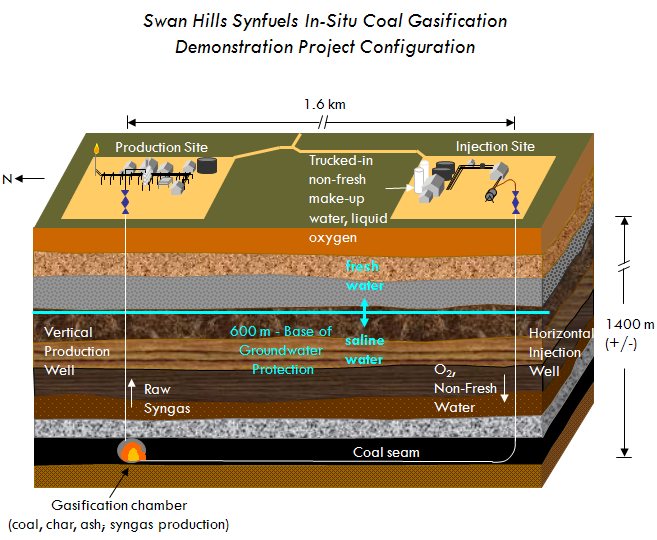
Swan Hills Synfuels has secured a deep coal resource base that can support the development of over 16 TCF (natural gas equivalent) of synthetic gas, based upon the results of its ISCG Demonstration Project (Demo Project) in the Swan Hills area of Alberta.
Through the results of the Demo Project, Swan Hills Synfuels has shown that ISCG, together with CCS, can cleanly tap the energy potential of Alberta’s vast deep unmineable coal reserves.
Gasification was first developed in the 1800s and has been used commercially throughout the world for more than 100 years. A variety of industries have utilized the technology including chemical production, fertilizer manufacturing, and electrical power generation. Today, the majority of the operating gasification plants worldwide are surface gasification plants designed to produce chemicals, fuels, electricity, and fertilizers.
As of 2008, there were 420 gasifiers at 140 facilities in operation globally, the majority of these being surface gasification plants (source – GTC). World gasification capacity is projected to grow by more than 70% by 2015 with much of the growth occurring in Asia (source – GTC). A number of factors contribute to a growing interest in gasification, including volatile oil and natural gas prices, more stringent environmental regulations, and a growing consensus that CO2 management should be required in power generation and energy production.
Feedstock (for ISCG, it is deep coal) is exposed to high temperature and high pressure. In the presence of steam at these conditions a series of chemical reactions occur which convert the feedstock into synthetic gas.
In the case of ISCG, this chemical conversion of the deep coal happens in place in its original seam. The resultant synthetic gas created consists primarily of methane and carbon dioxide, with small amounts of hydrogen and carbon monoxide.
To create this chemical conversion, two wells are drilled into the deep coal seam. A horizontal injection well is used to introduce oxygen and water into the seam; the oxygen supports a limited and controlled amount of combustion, raising the temperature of the coal and boiling the water to generate steam.
The naturally existing deep underground pressure, along with the elevated coal temperature and the presence of steam, together form the right conditions to gasify the coal. The vertical production well is used to conduct the raw synthetic gas to the surface. Char and ash, which are remnants of the original coal, remain deep underground.
Figure 1. ISCG Well Pair Schematic

Once at the surface, the raw synthetic gas is then processed to remove its carbon dioxide (CO2). This CO2 is then put to use in enhanced hydrocarbon recovery, to recover oil from conventional fields that would not be recovered by other means. The processing of the synthetic gas is done with conventional, proven processes from the natural gas processing industry.
The coal seam for ISCG development at the Swan Hills Synfuels site is 1400 m beneath the surface, approximately 800 m below the Base of Groundwater Protection (depth limit of fresh groundwater – below this depth, groundwater is saline), eliminating potential for fresh groundwater contamination. Saline water is used for injection into the coal seam through the horizontal well, virtually eliminating the need for fresh water in the ISCG process.